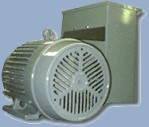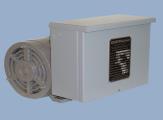High Efficiency Rotary Phase Converters
 Totally-Enclosed Fan-Cooled ROTOGEN (RTG-Series) cast-iron rotary models are rain- and dust-tight and rodent-proof and are ETL-Listed. All GWM Rotary Converters feature an Industry Exclusive Unconditional Lifetime Warranty against rotor failure.
Totally-Enclosed Fan-Cooled ROTOGEN (RTG-Series) cast-iron rotary models are rain- and dust-tight and rodent-proof and are ETL-Listed. All GWM Rotary Converters feature an Industry Exclusive Unconditional Lifetime Warranty against rotor failure.
 Economically-priced DP-Series Open, Drip-Proof cast-iron rotary models operate quietly in clean indoor applications. You may operate single or multiple motors, transformers, and resistance loads at 100% power in a broad range of applications.
Economically-priced DP-Series Open, Drip-Proof cast-iron rotary models operate quietly in clean indoor applications. You may operate single or multiple motors, transformers, and resistance loads at 100% power in a broad range of applications.
Phase converters will not change voltage. The single-phase input voltage is the same as the 3-phase output. Specify operating voltage when ordering: 208/230 or 440/480 volts 50/60 Hz. This is the cost-effective way to produce 3-phase metered at cheaper single-phase rates, and electrical efficiency above 95%. All models run cool and quiet, and may be left idling for long periods without overheating. Complete easy-to-follow instructions furnished.
Choose the rotary that meets your requirements and add the appropriate prefix (RTG or DP) to the rotary frame number to complete the Model Number.
| Rotary Frame/Model | Actual Rotary HP Rating | Largest Starting Load†† Light/Normal/Tough | Average Multi-Motor Load** | Motor Load Largest/Smallest | Rotary Disconnect Fuse(s) | Minimum 1-Phase Service Entrance | Shipping Weight |
|---|---|---|---|---|---|---|---|
| 184 | 5 | 4/2/1.5 | 8 | 4/.25 | 15 | 30 | 120 |
| 215 | 10 | 8.5/5/3 | 17 | 8.5/.5 | 30 | 60 | 195 |
| 254 | 15 | 12/7.5/5 | 24 | 12/1.5 | 40 | 80 | 298 |
| 256 | 20 | 17/10/7.5 | 34 | 17/2 | 60 | 100 | 330 |
| 286 | 30 | 25/15/10 | 50 | 25/4.5 | 80 | 150 | 465 |
| 324 | 40 | 35/25/15 | 70 | 35/7 | 100 | 200 | 588 |
| 326 | 50 | 45/30/20 | 90 | 45/10 | 125 | 200 | 698 |
| 364 | 60 | 55/40/30 | 110 | 55/12 | 160 | 250 | 980 |
| 365 | 75 | 65/45/35 | 135 | 65/14 | 200 | 300 | 1150 |
| 324x2 | 80 | 70/50/40 | 150 | 70/14 | 2-100 | 300 | 1195 |
| 364x2 | 120 | 100/70/50 | 220 | 110/24 | 2-160 | 400 | 1960 |
Power Requirements
Every 100 amps of single-phase supply will operate about 18 hp of 3-phase motors (@230 volts). NEC (1993) Requirements: Add the amps of all your 3-phase equipment (excluding the converter) and multiply the total times 2.5 for the single-phase service amperage requirements.
The “minimum 1-Phase Service” for each model Rotary is the service entrance minimum at the address where the converter is operated—not the amps to be dedicated strictly to the converter. This requirement ensures that enough power is available to handle motor and phase converter starting demands. Also confirm that your building service has an adequately-sized utility transformer for your loads. A number is usually stenciled on the side of the transformer and may be read from the ground. A 200 amp service should have at least a 25 or 37.5 kVA transformer, a 400 amp service—50 or 75 kVA. You will need 1 kVA for every 1 HP of fully-loaded 3-phase motors you wish to operate at one time, in addition to the kVA for the other loads in the system. Your electrician or local power company can help figure the requirement, or call us with a list of your 3-phase loads. Also see, “Dealing with your Utility Company,”
“Light Dimming” and Phase Converters
Momentary light dimming may occur when a large electric motor is started because of the high “inrush” current required. A rotary converter starts like a motor and may also cause light-dimming. Once started, however, the rotary can run all day without restarting, and will actually “cushion” the starting of 3-phase motors in the system, minimizing light flicker. The reason is that 3-phase voltages drop momentarily on any rotary converter when sudden loads are introduced, and lower voltage means reduced starting inrush currents. Motors on most CNC machine tools, however, are powered by a Vector Drive and produce almost zero additional inrush, so that a 30 HP CNC spindle motor requires no more starting current than a normally started 5 HP motor. Most CNC, however, will tolerate virtually no voltage drop during operation and thus require a very large rotary converter relative to the CNC spindle motor HP. GWM’s DIGI-Series sizing reflects this requirement.
In residential or other areas (i.e. the entire state of Idaho) where “inrush” limitations are in place, you may either accessorize your GWM Rotary Converter with our Line-TamerTM soft-start option, or use two smaller rotary units in place of one large model—for example, use 2 Model 256 rotary’s, started one at a time, as opposed to one 324 model—to lower starting inrush and “line disturbance.” If you are operating a business in a residential area and want to avoid annoying your neighbors, you may want to give particular attention to one of these options. For the LineTamerTM option see the Accessories section (Page 16)
Truths and Myths about Multi-Motor Ratings
Any phase converter multi-motor rating assumes that not all the motors in the system are heavily loaded. Lightly-loaded motors may actually aid in the operation of heavily-loaded ones. This is a universal presupposition among phase converter manufacturers.
In contrast, grain fan or pumping applications are intense loads, and if several large motors of this type make up the bulk of your operation, one of two options must be exercised:
(A) De-rating the converter (select a larger converter or converters relative to the total HP load), or;
(B) Use the small rotary and connect capacitor panels (see the Accessories page) to one or more large motors in the system.
Sometimes it is impossible not to add some capacitors, but option A is the one recommended by GWM. Besides the potential for mis-connection during later equipment changes, in November 1997 the EPA mandated higher efficiency energy standards which made motors more difficult to operate on any phase converter, regardless of manufacturer. Adding capacitors to a high-efficiency motor design usually causes more problems than it solves. More rotary mass relative to the load is necessary.
A customer was recently told by a salesman from another company that their 364-frame (60 HP) rotary converter would operate a total load of 95 HP of fans and pumps that were all heavily loaded. (We recommended two 364’s!) They got the sale, but their converter would not perform as stated without additional equipment. Remember: Correction of problems in an installation always adds disproportionately high costs.
If your installation includes multiple large motors on fans, pumps, or refrigeration equipment please consult our customer service department before finalizing your converter selection. Also remember that a company that wants to sell you a smaller converter than everyone else does may not be up to speed on current motor design.
Dealing with your Utility Company
Care taken in approaching your power company will usually get you the required equipment if a larger transformer is needed. When requesting a larger-than-standard (for your utility supplier) transformer, offering to pay a small additional monthly charge to the utility helps to get you a fair hearing. Larger transformers consume more electricity to magnetize their core, and also cost more to buy. It is helpful—once you determine the transformer necessary—to preface your request with, “The manufacturer of some equipment I am purchasing advises us that we need a (fill in the blank) kVA transformer from our utility supplier. Could you increase . . . ?” etc. And at this time your utility or the electrical inspector for your area may also inform you of any restrictions on home-operated businesses which may disqualify you for such equipment. Machinery bought for your own personal use or projects—such as building a race car, model building, etc.—shouldn’t affect you, however.
In a county-approved, home-operated business environment in which a utility supplier “woo’s you around” with endless engineering studies of your power supply problem, you may—in isolated instances—need to contact your representative in the state legislature and/or the State Board of Public Utilities to get a recalcitrant utility moving on your problem. One legitimate argument, for example, is that a 15 kVA transformer on a 200 amp service is only rated to carry 62 amps continuously! (15000va divided by 240 volts=62 amps.) This may persuade power company engineers that you know how equipment is rated and they may not be able to hide behind residential transformer standards in a commercial setting. Fortunately most utilities will deal more kindly with you than this. But bureaucracies are characteristically slow moving, and this doesn’t help when you are making $1500 payments on a CNC, whether you get to use it or not. Checking these things out in advance may save you hours of frustration later. If the utility engineer has any questions you can’t answer, we at GWM will be glad to help you make your case with them.
